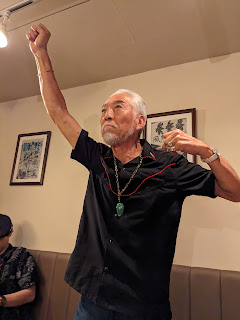 |
| Director Masaaki Tezuka shares his memories of working with Wataru Mimura. Photo by Brett Homenick. |
In the afternoon of Saturday, August 26, I attended a special memorial celebration in honor of screenwriter Wataru Mimura. Mimura-san passed away on August 26, 2021, after a years-long battle with multiple system atrophy. Due to the pandemic, no such events were held in the wake of his passing, but, given the recent end of the pandemic, the event was finally held.
Mimura-san wrote or co-wrote the screenplays or Godzilla vs. Mechagodzilla II (1993), Orochi the Eight-Headed Dragon (1994), Godzilla 2000 (1999), Godzilla vs. Megaguirus (2000), Godzilla against Mechagodzilla (2002), and Godzilla: Final Wars (2004). While he doesn't seem to get much credit for it, it's really impressive just how much of the Millennium series was written in Mimura-san's voice.
 |
| Hiroshi Kashiwabara. Photo by Brett Homenick. |
The event, which was called "Gathering in Memory of Wataru Mimura" by the organizers, was held on the 12th floor of the Chofu City Cultural Hall Tazukuri. The location was quite apropos, given that Mimura-san helf many of his P-LABO FILMFES events there. In attendance were many of Mimura-san's colleagues from his days at Toho and beyond. Among the luminaries were producer Shogo Tomiyama, director Masaaki Tezuka, screenwriter Hiroshi Kashiwabara, kaiju suitmaker Shinichi Wakasa, assistant director Toshifumi Shimizu, production designer Toshio Miike, and director Takao Okawara.
 |
| With Yasutaka Ito (left) and Hiroshi Kashiwabara (center). |
Due to my work schedule (how often do you hear me say that?) I arrived rather late -- maybe about an hour or so into the proceedings. Given that the celebration was scheduled to last only two hours, I ended up missing about half of it. But I certainly wanted to take part in any way I could.
 |
| With Toshifumi Shimizu. Photo by Brett Homenick. |
Even though I submitted my reservation to join, I guess it never got delivered, as my name wasn't on the list. (Don't you hate when that happens?) No worries, though. All I had to do was write my name on the guest list, pay the entrance fee, and I was all set. Many thanks to Kashiwabara-san (who also served as a staff member for the event) and my friend Hitomi, who was very close to Mimura-san, for helping to square things away.
 |
| Shogo Tomiyama. Photo by Brett Homenick. |
Many speakers talked about their memories of Mimura-san, and, as you could imagine, they sometimes got quite emotional. It was very moving to see how much Mimura-san affected people's lives in such a positive way. Shogo Tomiyama essentially acted as emcee and did a tremendous job keeping things moving along. The event ultimately finished right on time, and the last speaker, scriptwriter Yasutaka Ito, finished his remarks basically on the dot.
 |
| With Shogo Tomiyama. Photo by Brett Homenick. |
Of all the luminaries on hand, I spent the most time speaking with Kashiwabara-san, who is one the nicest personalities I've met in Japan. A couple of weeks ago, he sent me a message about the event, but by then I'd already submitted by reservation (which, as we know by now, wasn't received). During our online chat, I told Kashiwabara-san that The Great Escape (1963), one of his all-time favorite movies, would be screening at the Shin-Bungeiza theater. The timing didn't work out, unfortunately, as Kashiwabara-san would be out of town during that time.
 |
| Shogo Tomiyama addresses the attendees. Photo by Brett Homenick. |
I only got to say a quick word to director Okawara as he was leaving (we both just said "thank you" to each other for coming), but I went up to Shimizu-san to praise him for his work on The Mysterians' (1957) 4K restoration. I told him it looked fantastic, which he was happy to hear. I also talked for a bit with Tomiyama-san and congratulated him on a job well done.
 |
| With Hiroshi Kashiwabara. |
I hadn't seen Hitomi for several years, so it was great to see her again. Around 2015, we used to go out for karaoke, but life got in the way, and we more or less lost touch. Out of all the attendees there, I hung out with her the most, and it was wonderful to see her again.
And that's a wrap. It was a great way to celebrate the life and career of Mimura-san, who had been one of the kindest people to me essentially ever since I stepped off the plane in Japan. The news of his untimely passing was devastating, but I'm grateful for the time I had in his company. I think this celebration gives all of us a sense of closure.






















































